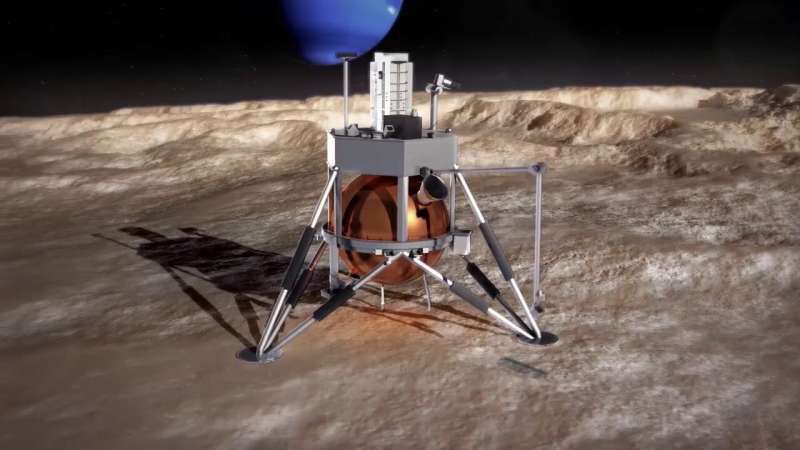This article has been reviewed according to Science X's editorial process and policies. Editors have highlighted the following attributes while ensuring the content's credibility:
fact-checked
trusted source
proofread
A hopper could explore more than 150 km of Triton's surface in two years

Neptune's largest moon, Triton, is one of the most biologically interesting places in the solar system. Despite being hard to reach, it appears to have active volcanoes, a thin atmosphere, and even some organic molecules called tholins on its surface. However, Voyager only visited it once, in passing, 35 years ago.
Technology has advanced a lot in the intervening decades, and a new push for a lander on Triton specifically has been garnering attention. One such mission was described by Steve Oleson and Geoffrey Landis of NASA's Glenn Research Center.
Their concept mission, known as Triton Hopper, was funded by NASA's Institute for Advanced Concepts (NIAC) back in 2018 and utilized a cryogenic pump to extract propellant from Triton's surface to power a "hopper" that could travel up to 5 km a month, and do some fascinating science along the way.
The first challenge to any mission on Triton is getting there. As part of the NIAC final report for the Triton Hopper, the authors performed a preliminary study examining different propulsion methods. Solar electric propulsion and aerobraking in Neptune's larger atmosphere came out on top. The Hopper would have to hitch a ride with a larger orbital spacecraft responsible for trajectory planning of the "hops" and communicating with Earth.
Once safely deposited on Triton's surface, a hopper could do lots of exciting science. The instrument payload described in the mission brief included ground-penetrating radar, spectroscopy equipment, a microscope, and even a seismometer. In total, the whole system weighed just under 300 kg—relatively light for an interplanetary mission.
But most of that weight wouldn't be in the instrumentation—it would be in the Hopper's unique propulsion system. The concept behind the propulsion system is simple enough: Get some propellant material into the spacecraft, then heat that material to a point where it is pressurized. Once enough pressure is built up, release it as a jet stream that would allow the 300 kg spacecraft to overcome the relatively weak gravity of Titan, which is only half the gravity of our own moon.
The study focused on two main ways to get material into the Hopper—a shovel and a cryogenic pump. Each has its advantages, though the pump was more effective, at least in the theoretical simulations run as part of the Phase I project.
The shovel suffered from potential contamination by other material being loaded into the propellant collection hopper and either blocking the nitrogen-rich ice and snow from entering it or itself being absorbed into the thermal chamber and sucking up some of the heat intended to melt the propellant.
On the other hand, a cryopump could use waste heat from the rover's normal power-generating operations to directly melt the ice and snow the Hopper landed on and absorb that into a heating chamber, where it would be further heated before being used as a propellant. This methodology can be effective at gathering the best propellant options and providing an outlet for the lander's waste heat that doesn't just radiate into Triton's thin atmosphere.
Once enough pressure is built up by heating the propellant, the Hopper can take off from the moon's surface and "hop" a short distance using its six power and four steering thrusters. The authors estimate about 50 seconds of specific impulse once a month. While that might not seem like a lot, it would allow the Hopper to cover about 150 kilometers over the course of a two-year mission.
It could find plenty of interesting scientific spots in those two years. However, the mission, which is also competing for resources with plenty of other mission concepts for Triton landers, appears to be on hold. It hasn't received a Phase II, and there haven't been any development updates in the last few years.
But given the general popularity of the hopper concept even on other worlds in our solar system and the desirability of Triton as an exploration destination, it seems likely that someday some form of this mission will soar above the ice surface of Neptune's biggest moon. It might just be a while before it does.
Provided by Universe Today




















